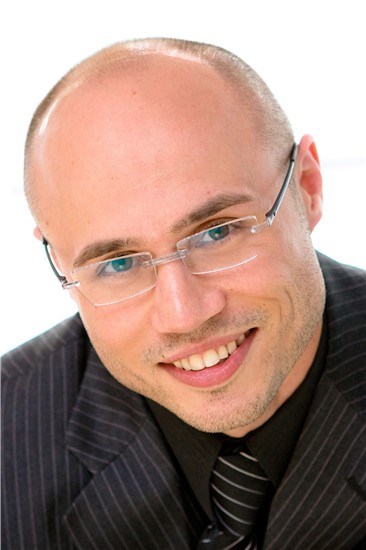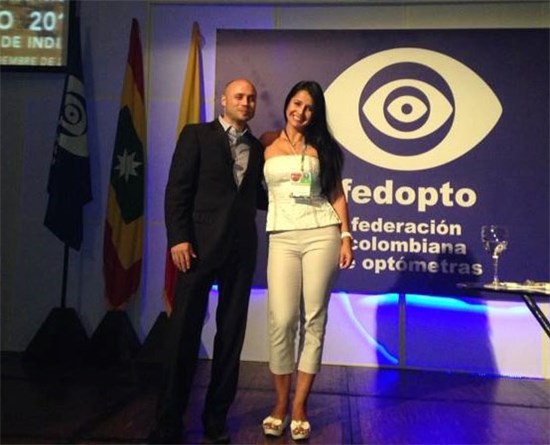By Justin Bazan, OD

May 27, 2015
SYNOPSIS
Giving presentations at optometric conferences introduces you to peers, and allows you to network, build your career–and bring back winning ideas to help your practice grow.
ACTION POINTS
PARTICIPATE FIRST. Attend the conferences you want to speak at first, introduce yourself to organizers.
BE DYNAMIC. Offer dynamic presentations, with audience interaction and engaging media, like videos from YouTube.
CONTINUE CONVERSATION. Parlay presentations into ongoing conversations with audiences by letting them know where to find you and how to get in touch.
Giving presentations at optometric conferences has allowed me to make important connections in our profession, while imparting information that can help other ODs.

Dr. Bazan with Angela Dussan, OD, at the last La Federación Colombiana de Optómetras (FEDOPTO) conference. Dr. Bazan says the first step to becoming a presenter at optical industry conferences is to become a participant.
Attend Conferences Where You Want to Present
True to my digitally driven nature, I developed a high visibility in online optometric circles. I was a frequent “face” on the Optcomlist, and had a reputation for out-of-the-box thinking and utilizing new technology.
The founder, leader and optometric legend Walt Mayo, an integral part of SECO, was looking for new speakers to cover some tech topics. He approached me about giving a few talks at SECO, and despite several reservations, I managed to reply “Yes!” I was so fortunate to recognize the opportunity, overcome my fears of public speaking, and then to go for it. This happened about five years after I graduated from optometry school, and after about a year of being active online.
My advice for those who are interested in speaking is to not wait around for somebody to approach you. Go out and make it happen. Pick a topic you are passionate about. That passion will help make up for the lack of experience in public speaking. There are lists online of all of the CE opportunities for ODs. You can go to the web sites and find out the details about submitting courses. I can tell you they are definitely interested in new speakers covering hot new topics. I would advise that you have at least three course ideas because it’s rare that a conference would invest in you for just one course.
Refine Details of Speaking Agreement
There are a variety in ways in which the details about my speaking engagements get done. Sometimes, I will agree to speak without discussing the details because I might have a strong relationship with the person who is facilitating the speaking arrangement. I know they will be offering good compensation, so I don’t worry about it.Other times, I’m asked upfront what my fees are, and we work from there. My fees vary depending on the cause, event or relationship with a person or company. I’ve been known to help special groups out by offering special fees. For example, for my alma matter, State University of New York (SUNY) College of Opometry, I’ve been known to donate my services. The larger conferences have standard contracts, which need to be completed, signed and returned by a set date. I have always been treated well by everyone in the industry. No conference or event organizer has ever treated me unfairly or taken advantage of me.
I’ve been paid as much as $1,200 for 15 minutes of speaking!I also often have mytravel expenses covered by the conference or sponsor.
Related ROB Articles
Optometric Conferences: Strategize to Optimize
Finding Your Flow: Is Optometry Fulfilling?
Continuing Education: Avoid Procrastination–and Optimize!
Develop Presentation
The first step is to simply think about the presentation. I will work on it in my head, and get it pretty much done on a continual basis from the time I first learn of the topic. I sift through relevant content, drawing out what I think will be most interesting for the specific audience I will be presenting to. The presentation builds over time, and eventually the ideas and concepts will congeal. I typically start the actual presentation the night before it’s due, working all night on it, just taking a brief break/nap. I then make final tweaks before submitting it. The deadline is often several weeks before the actual presentation. That said, I often tinker with the presentation right up until I deliver it. This is especially true for first-time presentations.
Avoid PowerPoint Zombie Presentation
I have an engaging presentation style. I don’t use PowerPoint. However, I do use something that has PowerPoint-like features. I use a cloud-based online presentation application called SlideShare. My style is different than most of the optometric presenters I know of because my topics are not as, for lack of a better word, “dry,” which allows me some freedom to depart from the norm. I have very few words on the slides, many with just full-screen images. I tell a story about the images, and encourage people to raise their hand and interrupt me with anything they want to share, like or comment on.
I encourage people not to put away their laptops or phones, and to use social media either live or later to get the word out about the presentation topic. I will talk with people before we start and get an idea of who I can work with during the presentation. Often, I will just call on people, and talk with them during the presentation. I like to ask the audience a lot of questions, and encourage people to share their knowledge.
I accept that not everyone will be engaged in my presentation, including those who spend the presentation scrolling through their phone or tablet. Tune in or zone out–it’s all good with me as long as they are not messing up other audience members’ experience, such as by creating a distraction with side conversations. People participating in side conversations sometimes have great insights, so I will often just put them on the spot and ask them to share.
In addition to the live presentation, I have learned that people like when I make full-text summary slides available online. They are slides I include for people who are reviewing the presentation at a later time. All of my presentations live in the cloud, and often I have accompanying audio. This makes it easy for anyone to revisit the presentation at a later date. I also have a couple presentations that are video-recorded and available on YouTube.
Set Stage for Continuing Conversation
The last thing I say in my presentations: “I’m not hard to find. If you have to run, just Google me. However, I’m going to stick around here now, so if you like what we talked about today, please come up and say hi. I’d also love to answer any questions that you guys have for me.”If I’m not running off, I will invite people to grab a drink or have a meal with me. I love meeting new people and sharing ideas. At a minimum, I encourage people to keep in touch often through e-mail or social media.
Focus On Refining Presentation Skills
As with nearly everything in life, the more you learn and practice presentations, the better you will get. Take notes on great speakers. Learn what they do best and adapt those skills and work them into your own.I’ve learned so much just from watching TED talks and the greats in our industry.I also read up on the art of giving presentations. I like to use Amazon to see what books on presentations are popular, and preview them to see if the presentation style offered in the book clicks with me. Then, the best thing to do is to just do it. The “seasoning” process is really organic, and you will see yourself evolve and improve with each presentation.
Justin Bazan, OD, of Park Slope Eye in Brooklyn, NY, started his own practice cold. He speaks regularly on strategies for marketing your practice via social networks. Contact: dr.bazan@parkslopeeye.com



























